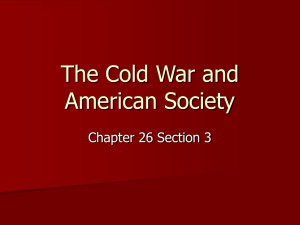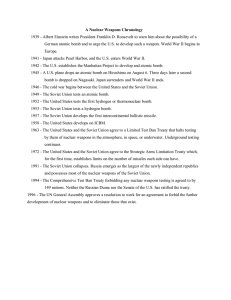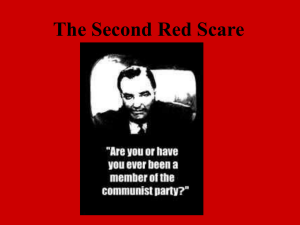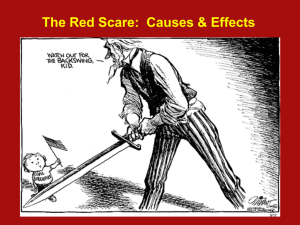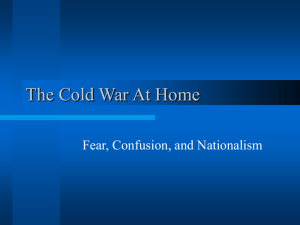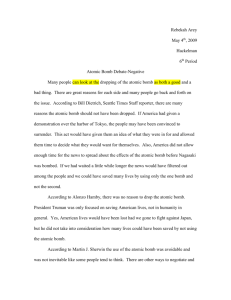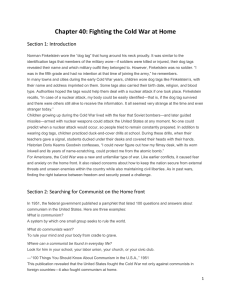Red Scare - ToddJenkins
advertisement
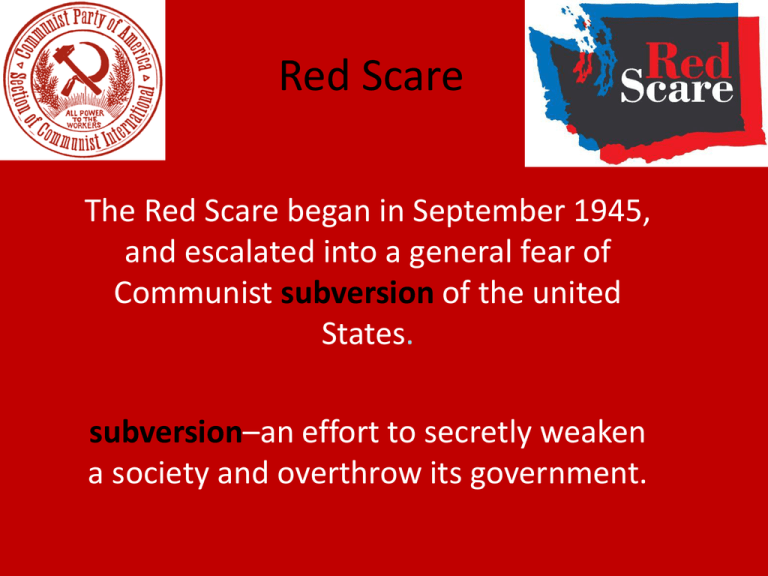
Red Scare The Red Scare began in September 1945, and escalated into a general fear of Communist subversion of the united States. subversion–an effort to secretly weaken a society and overthrow its government. Truman and the Red Scare • Truman implemented loyalty review program to screen all federal employees for their loyalty. • The program’s aim was to calm Americans. • Instead, it led to the fear that Communists were infiltrating the government. J Edgar Hoover • First Director of the FBI • Hoover went to the House Un-American Activities Committee (HUAC) to urge them to hold public hearings on Communist subversion. • Under Hoover’s leadership, the FBI sent agents to investigate suspected groups and to wiretap thousands of telephones. Alger Hiss • Hiss had served in Roosevelt’s administration, attended the Yalta conference, and helped with the organization of the UN. • Most prominent government official that was accused of being a Communists or spies by HAUC. • Hiss denied the charges, but he was convicted of committing perjury, or lying under oath. Red Scare intensifies • The search for spies intensified when the Soviet Union produced an atomic bomb in 1949 and further intensifies in 1961 when they came up with a Hydrogen Bomb. • Klaus Fuchs, a British scientist, admitted giving information to the Soviet Union about the Atomic Bomb. Julius and Ethel Rosenberg • A New York couple who were members of the Communist Party and were charged with heading a Soviet spy ring and selling secrets to the Soviets. • Although many believed the Rosenberg's were not guilty, the couple was executed in June 1953. Project Venona’s • In 1946 American cryptographers cracked the Soviet spy code, allowing them to read messages between Moscow and the United States. • This did not become public knowledge until 1995, when the government revealed Project Venona’s existence. “A Conspiracy So Immense” • In 1949, with the Soviet Union testing an atomic bomb and China falling to communism, Americans felt they were losing the Cold War. • Senator Joseph R. McCarthy, in a political speech, stated that he had a list of 205 Communists in the state department that were behind a Soviet spy ring. McCarran Act • Congress passed the Internal Security Act or McCarran Act in 1950. • The act made it illegal to “combine, conspire, or agree with any other person to perform any act which would substantially contribute to . . . the establishment of a totalitarian government.” McCarthyism • Others made similar charges, causing Americans to begin to believe them. • Senator Joseph R. McCarthy became the chairman of the Senate subcommittee on investigations. • His investigation turned into a witch hunt as he searched for disloyalty based on poor evidence and fear. • He ruined reputations without proper evidence. • In 1954 Americans watched televised Army-McCarthy hearings and saw how McCarthy attacked witnesses, and his popularity faded. Finally, an army lawyer named Joseph Welch stood up to McCarthy. • Later that year, the Senate passed a vote of censure, or formal disapproval, against McCarthy. Atomic Treat • Communism and the threat of the atomic bomb dominated life for Americans and their leaders in the 1950s. • The threat of an atomic attack against the United States forced Americans to prepare for a surprise attack. • Although Americans tried to protect themselves, experts realized that for every person killed instantly by a nuclear blast, four more would later die from fallout, the radiation left over after the blast. • Some families built fallout shelters in their backyards and stocked them with canned food.
